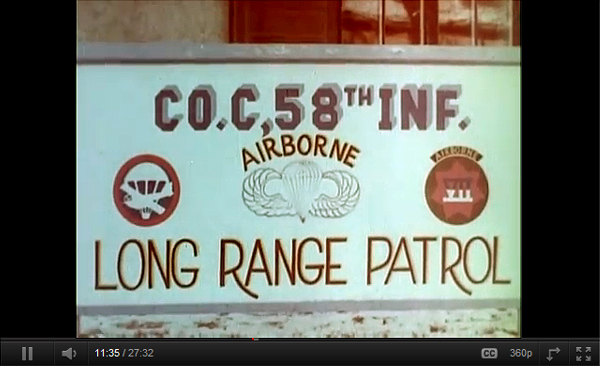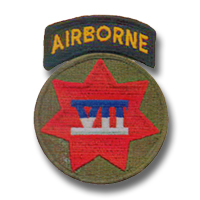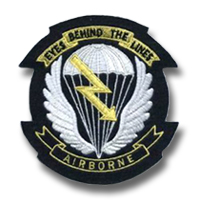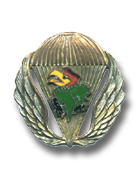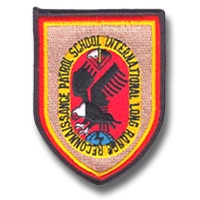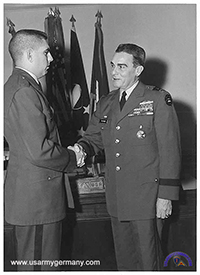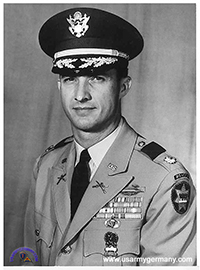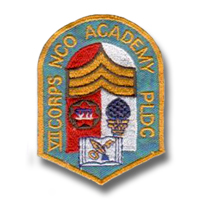| If you do
NOT see the Table of Contents frame to the left of this page, then
Click here to open 'USArmyGermany' frameset |
||||||||
VII Corps Special Troops |
||||||||
|
|
||||||||
|
||||||||
|
|
||||||||
| VII Corps Special Troops Battalion | ||||||||
| (Source: STARS & STRIPES, Jan 7, 1967) | ||||||||
| HQ VII Corps has been reorganized -- units that formerly were attached directly to HQ are now reassigned to the newly formed VII Corps Special Troops (Provisional). Five companies, a platoon and a detachment now make up the provisional battalion. One of the changes included the reassignment of the attached US Air Force Weather detachment to the 16th Aviation Battalion. |
||||||||
| The following changes were noted by Dave while reviewing the 49th Anniversary issue (published on Aug 18, 1967): 82nd Army Band now assigned to VII Corps Special Troops VII Corps Aviation now comprised of ... |
||||||||
| (Source: 52nd Anniversary, 1918 - 1970. The JAYHAWK Anniversary Issue, August 19, 1970.) | ||||||||
| The VII Corps
Special Troops Bn is commanded by Lt
Col Julian H. Smith, who replaced Lt Col Ernest M. Breuer in July. The Battalion participated in a reduced-distance Command Post Exercise at Kelley Barracks prior to Exercise Front Centre '70 to identify and eliminate problem areas. During the exercise, the battalion was responsible for the movement of Corps Headquarters to and from the exercise area, arrangement of Corps Headquaters elements and logistical support. Subordinate units are: |
||||||||
|
|
||||||||
| VII Corps LRRP | ||||||||
| (Source: Anselmo "Sam" Rodriguez, Co. C (LRP) 58th Inf. (1966-1968), and the VII Corps LRRP (ABN) Assn.) | ||||||||
VII CORPS LRRP (ABN) CO. Co. C (LRP) 58th Inf. Nellingen, Germany B Co. 75th Rangers Ft. Riley , KS |
||||||||
A History compiled by Anselmo Rodriguez Excerpts of the history courtesy Anselmo Rodriguez and the VII Corps LRRP Association. For more details and contact information please see the web site. |
||||||||
|
||||||||
| With the takeover of these barracks, the pre-WWII building was now the new home of the VII Corps LRRP Company. –Major Maltese and 1Sgt Flynn now began the search for suitable personnel, and a call went out for volunteers. Many of those who responded were veterans of WWII and/or the Korean conflict. Some had already served in the Army’s Special Forces. Others were American or German Ranger qualified. Still others were veterans of other US armed forces; a few had served in foreign armies or had been born and raised overseas and were fluent in other languages. Many of these men were former Army Paratroopers who saw an opportunity to get back on jump status by volunteering for the new company of LRRPs. The “Assignments NCO” at VII Corps would give Major Maltese a call once a month and say, “I’ve got a list of people you might be interested in.” Major Maltese would go over the list and pick out the ones he wanted. “We had a full company - it really filled up well. We got permission to recruit - most of them came from the “505”. I remember old Herb something from B Co 505, he tried to discourage them, called us a bunch of candy-asses, so I went up there - hell, I'm about forty-one years old, but in pretty good shape, and I said, “I'll take you out and we'll see who comes back.” “That was the end of that discussion.” –Col. Maltese |
||||||||
|
||||||||
| THE MISSION “To conduct combat surveillance and target acquisition operations behind enemy lines in the VII Corps area of influence.” –Company SOP Fact Sheet - Co. C (LRP) 58 th Inf. 1966 (LRRP CD) “The LRRPs (LRP after 1965 and Army Rangers after 1969) must not be confused with the well-recognized reconnaissance patrol that normally proceeds to an objective area to acquire certain information and then returns upon the accomplishment of the specific mission. Patrols are to see but not be seen. Their movements are restricted to periods of limited visibility or hours of darkness. During these periods they can expect to receive instructions to move and check suspected areas for command posts or large supply installations in their vicinity and to report on possible obstacles for future offensive plans along a route in their area of operation.” –Major Hunt “The primary mission of the Long Range Reconnaissance Patrol Company was to enter patrols into specified areas within enemy held territory to observe and report enemy dispositions, installations, and activities.” – Col Bingham An infantry Long Range Patrol is a specially trained military unit organized and equipped for the specific purpose of functioning as an all weather information-gathering agency responsive to the intelligence requirements of the tactical commander. These patrols consist of specially trained personnel capable of performing reconnaissance, surveillance, and target acquisition within the dispatching unit’s area of interest. Normally the LRRP (patrol) is placed in a position (within enemy held territory) to maintain surveillance over routes, areas, or specific locations for extended periods, reporting all sightings of enemy activity (along with strengths and weaknesses) within the area of observation. A LRRP patrol must be self-sufficient, operate effectively, and accomplish their assigned information gathering mission for extended periods with minimal or no outside support or re-supply. LRRPs originally operated in four-man patrols increasing to five-men after the LRP TOE was issued in mid-1965. SETAF used six-man patrols in Italy, as did the later LRRP units in Vietnam. Twelve-man combat or heavy patrols were put together for specific tasks. –Robert Murphy, V Corps LRRP Insertion methods varied. Patrols could be committed in planned locations behind enemy lines by stay-behind methods (A means of emplacement where a patrol would dig in and allow an overrun by enemy forces.) or delivered by land, water, or air, to include parachute. Night parachute insertion from large fixed wing aircraft such as C-124s and C-130s was considered normal. Small fixed wing aircraft such as L-20s or U1A Otters and CH-34 or CH-37 helicopters were also used. THE CZECH BORDER “In 1963, the company was given the mission to provide foot patrols along the Czech Border, along with the 2nd ACR. The LRRP patrols were able to get closer to the border than the vehicle-bound 2nd ACR. VII Corps G-2 confirmed that the border intelligence provided by the LRRP patrols was of strategic value to the US military and NATO. In a similar exercise, the employed LRRP patrols were pitted against the Army’s new airborne Side Looking Radar (SLR) system. The outcome: LRRP patrols averaged getting the information back to the VII Corps’ TOC twenty minutes to one hour before the SLR information was received. This record made a believer of the Corps’ G-2 Section and General Bonesteel, who was already an avid supporter of the LRRP concept .” – Col Bingham Several of the LRRPs who were involved in foot patrols along the heavily guarded West German Czech border have come forward with special memories. Pat Smith, a former Marine, recalls one border patrol in the early 60’s where he and Joe Chetwynd, VII Corps LRRP Assn. founder and first Assn. President, found that they were both on the Czech side. Before they could get back, a Czech two-man patrol with a dog came between them and the West German border. With the need to get back to the “West,” Joe decided that the best way to get out of this situation was to just walk over to the guards and ask for a match to light a cigarette. Needless to say, Pat thought it wasn’t a good idea but Joe, with the typical LRRP confidence, walked right up to the guards, and with their dog going nuts, asked for the match. A situation solved with a bit of LRRP bravado. John Wood , B Co 75 th Ranger and decorated Vietnam Veteran, provided another bit of information regarding patrols along the Czech border in the late 60’s and early 70’s. John’s comments were “However, as LRRPs/Rangers we did do some really hairy things. I wish you could get a hold of Sp/4 James, from Michigan somewhere. He had photographs of Russian guards looking through the fence at the West. Only thing was he was behind them when he took the photo, and the photograph was taken from the ground looking up. Sp/4 James had crawled up behind them and taken their photo. Not to mention how he got on the “Commie” side. But that picture will be in my memory forever. I knew I was with the right guys after that.” Photographs of the LRRPs on patrol along the Czech border can be found in the LRRP CD. For additional information regarding the “LRRP Organization and Employment Concept” check the LRRP CD for Major Hunt’s personal notes and Briefing. THE SECRET MISSION In the event of hostilities, NATO forces would need time to mobilize before confronting invading Soviet Armor. A 10:1 advantage in tanks ensured an initial Soviet advance. To slow the Soviet Armor, Corps devised a “top-secret” plan to use LRRP patrols to emplace small tactical nuclear weapons. These early large suitcase-sized nuclear devices were known as T-4 Small Atomic Demolition Munitions (SADM). “An SADM would be placed by LRRPs at important bridges and other choke points for the specific purpose of slowing the advance of invading Soviet Armor.”–Robert Murphy, V Corps LRRP “The atomic targeting mission was the reason the unit was a double volunteer organization. To minimize this threat to the patrols, the location of all known caves was maintained in Corps G-2 and LRRP Operations.” –Col. Ellis D. Bingham Selected patrols received specialized training for missions requiring emplacement of tactical nuclear weapons. For these missions, a former LRRP Officer, LTC Ed Mitchell (ret), then a 1LT who had come over from 3 rd Inf. Div LRRP, provided the following comment that “It was his job to select LRRP personnel who could do the job, but who were considered expendable”. He also remembers, “We were testing drops and jumps with ADMs and SADMs in the summer of ‘62 around Crailsheim and flying out of Schwabisch Hall in CH-21s and Otters.”SGM Rowe Attaway (ret) also added that “Patrols would be provided with seven days LRRP rations, expected to perform their assigned mission, and would then be written off the books.” Only those with a “need to know” were aware of this mission and the special training required. Those who did know would not discuss or confirm the mission until almost forty years later. |
||||||||
|
||||||||
|
|
||||||||
| 39th Transportation Company (Light Truck) | ||||||||
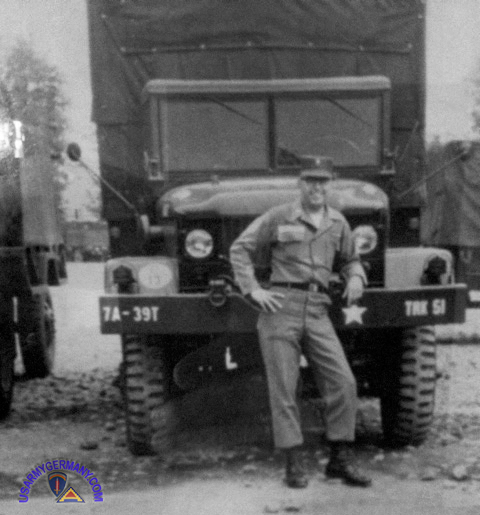 Lt William Phillips in front of a 39th Trans 2½-ton truck |
||||||||
| 1963 | ||||||||
| (Source: Email from William D. Phillips, former CO of the 39th Trans Co) | ||||||||
| In 1963/1964 I was in 39th Trans Co (Lt Trk) at Kelley in Special Troops Bn.
This web site refers to 29th Trans Co (now corrected by webmaster). I assume that is an error. The reference to the 527th Trans Co is accurate. The 39th provided ground mobility, among other things, to VII Corps G-sections. The 39th had, as I recall, a Hqs group; 4 truck platoons and a maintenance section overseen by WO4 Vernon Smith.
The 39th provided trucks and the 527th provided jeeps/sedans to support VII Corps Hq. When I came to Kelley in Mar 1963, the CO of 39th was John Brighten. The VII Corps Commander was General Bonesteel. The Special Troops Bn Co was LTC Joseph Love, a fine soldier who taught me much about the ”system”. The Bn SMaj was also named Kelley. He was a master of manipulating people and paper. I became CO in Mar 1964. Louis W Truman replaced Bonesteel as Corps Commander. LTC Melvin Kreiger replaced Love as Bn CO. Another fine soldier. I came home in Dec 1964 to practice law. I corresponded w/Col Krieger for many years after he retired prior to his death. Col Love, also retired, came to Pittsburgh about 25 yrs ago to visit his daughter in medical school. I connected with him through David Hackworth who was a retired Col and writer. Hackworth mentioned Love in one of his books. Col Love and I had a wonderful 3 martini lunch as we rehashed the Kelley days. Sadly he passed on in 2011. I still have some 35m slides from the Kelly days that I will try to find for your website. How do we try to locate 39th people from the 60s? I am very close with the aide to Corps Artty commander (Gen Garrison) from 1963 as well as JAGC officer and officer from the Signal unit. We all lived in BOQ. We are still in constant touch. But I have lost track of the 39th people. No doubt many of the senior NCOs are gone. |
||||||||
| 527th Transportation Company (Car) | ||||||||
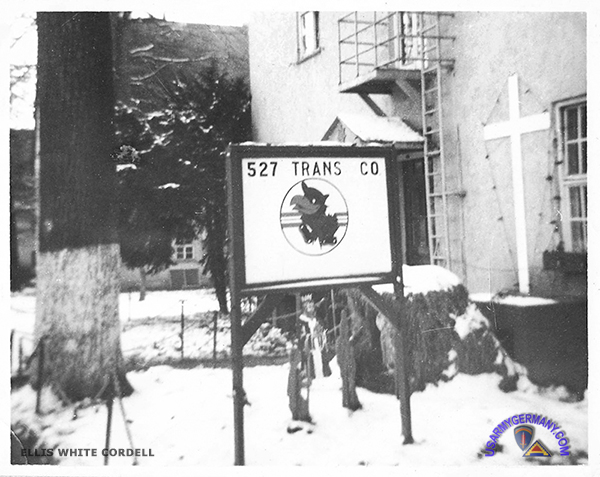 Nativity scene in front of the 527th Trans Co barracks, early 1970s (Ellis White Cordell) |
||||||||
| 1982 | ||||||||
| (Source: STARS & STRIPES, April 19, 1982) | ||||||||
| The 527th Trans Co (Car) is commanded by Capt John H. Moore and is stationed at Kelley Barracks, Möhringen. As part of the VII Corps Special Troops Battalion, the company is responsible for hauling passengers in support of VII Corps or higher headquarters. In accordance with a DoD directive to eliminate car companies, the unit has been scheduled to be inactivated on July 20, 1982. About 40 soldiers will be retained to form a transportation platoon, the remainder will be reassigned to other units. |
||||||||
| VII Corps NCO Academy (PLDC) | ||||||||
|
||||||||
|
|
||||||||
| Related Links: VII Corps LRRP (ABN) Association - website for former members of LRRP assigned to VII Corps at Nellingen 75th RANGER REGIMENT ASSOCIATION - very nice website also includes LRRP units assigned to V and VII Corps LRRP Company, 3rd Infantry Division - page on the SuaSponte web site (www.SuaSponte.com) |
||||||||

